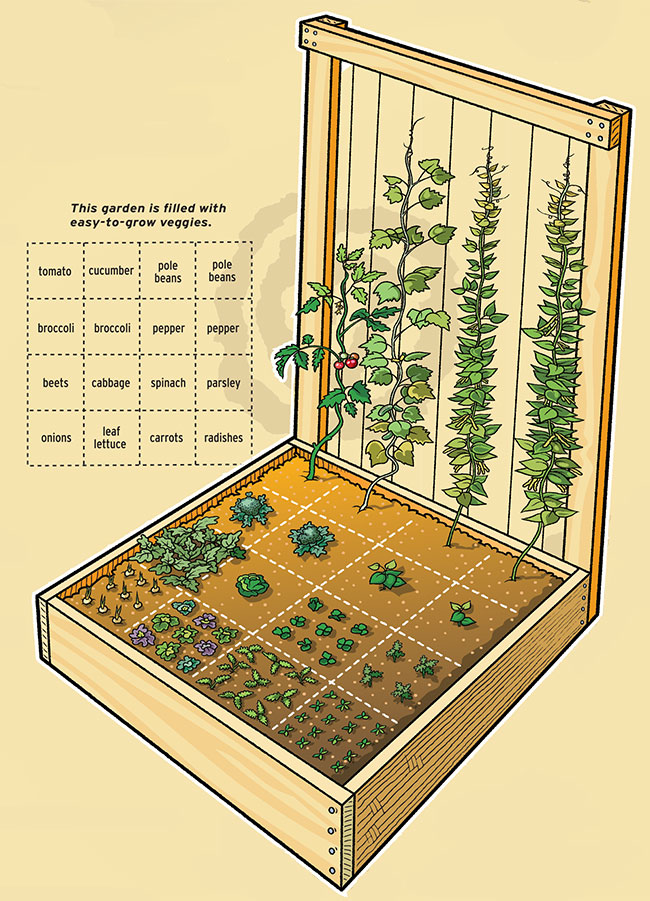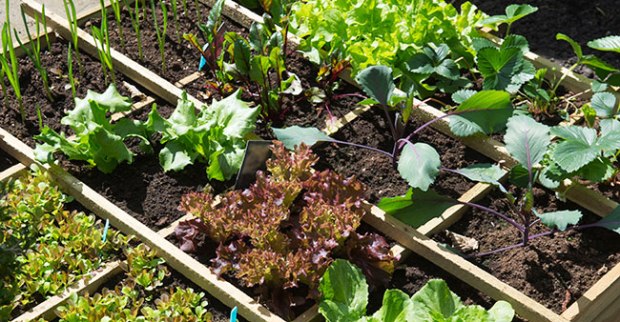How to Plant a Compact Vegetable Garden
What makes this compact garden so productive is that you will be placing plants close together in squares instead of traditional rows. You can continue to plant as you harvest.

What You’ll Need
- Hammer
- Saw
- Shovel
- Wire cutters
- Tape measure
- 4 4-foot 2-by-10’s
- 16d galvanized nails
- 2 6-foot 2-by-4’s
- 4-foot 2-by-4
- 49 feet of 12-gauge galvanized wire, cut into 7 7-foot lengths
- 8d galvanized nails
- About 1/2 cubic yard or 14 cubic feet of good garden soil
- A sunny spot for your garden
What You’ll Do
Frame
1. Using the 2-by-10’s and 16d nails, hammer together a 4-foot square.
Trellis
2. Nail the 6-foot 2-by-4’s to the back of the frame.
3. Nail the 4-foot 2-by-4 across the back of the uprights.
4. Attach the 7 wires on the back of the trellis by wrapping wires around nails.

Planting
Fill the frame with good garden soil. Divide it into 16 squares. The smaller the mature plant, the more you can plant in each square.
A Helpful Garden
Nail 5/8-inch or heavier exterior plywood to the bottom of the frame and lift the frame to table height by placing it on sturdy saw horses or legs. Once filled with soil, it will be easily accessible to a person in a wheelchair or someone who is more comfortable sitting than kneeling.
What kind of soil do you put in a raised bed? I used special raised mixture and my plants did not do well.
It’s not the same layout as in the diagram. I see one square with strawberries, not possible to grow like this, everything is too tight and sometimes not enough for a person. This would have to be a lot bigger.
Very good idea, looks great. Looking forward to trying it. Thank you for the idea. 😊
Try this : take a empty soda bottle / can / milk jug / large plastic container cut it in half . Then nail/glue/duct tape it to a wall then put dirt in it and put in plants or seeds repeat this multiple times to make a garden on a wall😀
Not a lot of veggies for all of this effort. Shame.
I have raised beds and use a thick permeable membrane secured down the sides and across the bottom then I use a 2 inch layer of stone chips. I use 6 inch wide treated decking on the bottom leaving 1.5 to 2 inch gaps in between for drainage, 2 years on all still intact and drainage working fine. The beds are on old bricks, again I use gaps so underneath can be hosed or swept.
Don’t plant tomatoes near Cucumbers. Do not store them in your frig near each other either. The chemical that a cucumber releases causes the tomato to go bad faster than it should. They compete in the garden.
Love this idea. I’m doing it.
liked it a lot. So nice if I could find the video to get more details
Not all these plants grow at the same time. Broccoli is a cool weather plant and tomatoes require sun and heat. Untreated lumber is preferred if garden soil touches it. No need for gravel at the bottom of a raised bed; it does not improve drainage. Good soil, compost, and proper amount of sunlight for the plant, plus appropriate watering are the requirements for a successful garden.
Would you please post a picture of the garden at maturity? These are feasts for my eyes.
after looking at this now I know how to make a really nice garden. thank you
while this method is great for starting out most plants that grow in areas that small tend to be undersized need more fertilizer and mildew more easily which is why professional gardeners plant vegetables in rows instead of raised beds or in close proximity to other plants
How many people can this feed?
If you put plywood on bottom..wouldn’t that cause mold and mildew ?
how do you protect your plantings from rabbits/birds etc?
What kept the squirrels and rabbits at bay around my house was a solution with cayenne pepper. It seemed to work quite well. I didn’t have trouble with birds as they ate any slugs or other insects that would have damaged my plants.
Look up companion planting and natural pest deterrents. By planting certain herbs, flowers or other veggie plants next to each other it wards off pests and critters by either rappelling them or attracting beneficial insects that will eat the bad ones. Most critters do not like marigolds, mint, oregano, lavender etc…
A better solution would be to use thick cardboard – not plywood. It will protect from weeds, kill grass underneath, attract earth worms (good for soil) and provide nutrients as it decays.
This is a great garden! I wish I could duplicate it somehow!
If you’re leaving it on the ground that would work, but the point in making a bottom in the first place is to be able to raise it, and cardboard wouldn’t be sturdy enough.
Beautiful idea!
Read the book Square foot gardening by Mel Bartholomew. He has a similar method. It is easy and fabulous. I have five boxes that feed our family of four very we’ll.
Looks like a nice garden ! Just big enough for my husband and I.
Marine grade ply will last
We built a raised bed similar to this but much bigger. We used cedar 6 x 6 removed the grass so no bottom was required on the structure. One side has asparagus that provides a great supply in early spring. The other is mostly herbs and tomatoes and rhubarb. I will try to add a trellis in the middle and try growing some runner beans along side the tomatoes.
We also plant tomatoes against our board fence and we get 8 foot plants that really produce. You just have to tie them to the fence in spots to help hold the weight.
All the plants in the diagram should not be planted at the same time. Most of them are to be planted in the Fall.
real method of growing our own veggies
Could you use the wavy roof material for the bottom… drill drain holes every so often, line with a small layer of stones and brace three times with treated wood on the bottom side?
DO NOT USE TREATED WOOD, IT CONTAINS ARSENIC!!!
Close planting (“overplanting”) doesn’t give weeds much room. I did this kind of garden once in a 7′ X 3′ plot outside my breakfast room window and grew the climbers on strings tacked to the window-frame. It was lush and wonderful!
Incorrect…. Arsenic has not been in consumer treated lumber for over 10 years.
Why would you put Broccoli near Tomato? Broccoli, cauliflower, cabbage, etc, as well as potatoes, inhibit tomato growth. Use basil, or something else that compliments tomatoes.
I read this before too
way to small for all those plants!!!!!!!!!!!!!!!
I love to bake by trade but am really excited to try my hand at a garden. Love to cook and my grandchildren are excited to eat veggies that we grow at home.
Nope. These are correct, except for the leaf lettuce which would be 4 per square. You could actually put in 16 carrots instead of the 9 shown. This is Square Foot Gardening and has been proven for 40 years.
It looks really great, but i’ve always learned that the combination tomato/cucumber very unfortunate is!
Seems kind of crowded, but I like the idea. I made some garden boxes today using the composite wood. Didn’t want to use pressure/green treated wood due to chemicals.
u are correct
Composite wood also has glue and other chemicals you do not want around your food source. I would to try replace it in time.
You can use rough-sawn hemlock from a local mill, it is naturally rot-resistant. Even regular pine should last a few years.
You can also treat your wood with edible oils to last longer. Old used vegtable oil works good.
Instead of using a tarp to controll weeds cover bottom of area with cardboard. It will allow water to drain and when it breaks down it becomes part of the soil
You do need to allow for drainage and should not use pressure treated wood.
Do not use green pressure treated lumber because it will leach into the soil. However, there is a red/brown pressure treated out there now that is not suppose to be toxic.
For a boy scout project I think its a great learning tool. I also think its a great starter plan that can be built on.
if you nail a piece of plywood on the bottom (to be able to raise it up… won’t you have drainage issues?
I used some old plastic shelving to raise my garden box up. It was the dark gray utility type shelving that has holes already in it. It worked perfectly. The garden produced great veggies all summer long. The plywood underneath does work also. The excess water finds its way out around the edges of the box. I know someone that has one like that going this year and it’s been successful so far.
Wouldn’t pressure treated woods leach into the soil when it rains?
Why can’t you use pressure treated for the side boards?
Excellent idea….going to do this spring….thank you
The idea is nice, but the plants that they mention to grow….you need more space. A tomato plant next to all the others? Unless you’re going to constantly trim it back, its not going to work.
It’s true, the tomatoes would normally need more space, but when you grow them up the twine trellis you prune any suckers and just grow a single stem up the twine. The plant takes up very little space this way.
If you ever find yellow leaves or dead leaves and all the rest is green it could and very well be a disease so pick the leaves off so it doesn’t spread.
The trellis, as long as directions are followed, shouldn’t need extra support. The taller the trellis, the more support it will need.
You could line the bottom with a tarp but to help with wood rot, try pressure treated boards.
DO NOT USE PRESSURE TREATED BOARDS!!!! They are treated with a chemical that is poisonous to humans, it could leech into your soil/water and get into your plants I repeat DO NOT use pressure treated wood anywhere near your garden.
I going to try this.
Does the trellis need extra support?
how days will it take to start getting tomatos after planting
Could u line the bottom with a tarp to help protect the wood from rotting or would that bleed chemicals into the soil?
a tarp would not allow for good drainage, and may speed up rotting. I would use weed block on the bottom to prevent weeds and place on the ground in a sunny spot.
you could drill holes in the plywood ‘floor’, but i would reinforce it with a couple of cross beams on the bottom